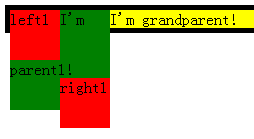css_03
1. Font attributes: ①Font format: font-family: Value: "microsoft yahei"/Arial...; ②Font size: font-size: Value: pt/px; ③Font bold: font-weight: Value: normal (default value)/bold (default value for bold, hn, b, strong)/400-900; ④ Font style: font-style: Value: italic (italic); ⑤ Small capital letters: font -variant: small-caps; ⑥ Font attribute synthesis: font: value: style variant weight size family; * Must include font-family attribute value;
2. Text attributes: ① Color: color; ② Typesetting: text-align: Value: left/center/right/justify; ③ Text modification: text-decoration: Value: none (none)/underline (underline)/ overline (overline)/line-through (strikethrough); ④ line height: line-height: vertically centered within the specified line height; ⑤ first line text indent: text-indent: value: px; ⑥ text shadow: text-shadow: Value: h-shadow v-shadow blur color; (*Explanation of visible css01 border shadow);
3. Table attributes: ①Vertical alignment: vertical-align: set in td; ②Border merge: border-collapse: Value: separate (default, separation)/collapse (merge); ③Border margin: border-spacing : One value specifies the margins on all four sides of the cell at the same time; the two values are horizontal and vertical (* in separated mode); ④Display rules: table-layout: Value: auto (default, automatic table layout, content determines the cell size, Adaptive, slow loading speed when complex)/fixed (fixed table layout, determined by the values of table and td, accelerated display, inflexible);
4. Floating: breaks away from the document flow and does not occupy page space; ① The last line break when the width of the parent element cannot accommodate all floating elements; ② After floating, they are all block-level elements; ③ When there is no size limit for floating elements, the width is adaptive according to the content; ④The level of floating elements is equivalent to text/inline/inline blocks;
5. Clear float 1: Clear the impact of other floating elements on the current element; clear: left (floating elements are not allowed to appear on the left)/right (floating elements are not allowed to appear on the right)/both (floating elements are not allowed to appear on both sides);
6. Clear float 2: Clear the impact of floating elements on parent elements; ①Set the height of the parent element; ②overflow: hidden/auto (the content will be hidden when there is overflow); ③Add block-level child elements and set the clear attribute value for both;




Hot AI Tools

Undresser.AI Undress
AI-powered app for creating realistic nude photos

AI Clothes Remover
Online AI tool for removing clothes from photos.

Undress AI Tool
Undress images for free

Clothoff.io
AI clothes remover

AI Hentai Generator
Generate AI Hentai for free.

Hot Article

Hot Tools

Notepad++7.3.1
Easy-to-use and free code editor

SublimeText3 Chinese version
Chinese version, very easy to use

Zend Studio 13.0.1
Powerful PHP integrated development environment

Dreamweaver CS6
Visual web development tools

SublimeText3 Mac version
God-level code editing software (SublimeText3)

Hot Topics
 What is the purpose of the <datalist> element?
Mar 21, 2025 pm 12:33 PM
What is the purpose of the <datalist> element?
Mar 21, 2025 pm 12:33 PM
The article discusses the HTML <datalist> element, which enhances forms by providing autocomplete suggestions, improving user experience and reducing errors.Character count: 159
 How do I use HTML5 form validation attributes to validate user input?
Mar 17, 2025 pm 12:27 PM
How do I use HTML5 form validation attributes to validate user input?
Mar 17, 2025 pm 12:27 PM
The article discusses using HTML5 form validation attributes like required, pattern, min, max, and length limits to validate user input directly in the browser.
 What is the purpose of the <iframe> tag? What are the security considerations when using it?
Mar 20, 2025 pm 06:05 PM
What is the purpose of the <iframe> tag? What are the security considerations when using it?
Mar 20, 2025 pm 06:05 PM
The article discusses the <iframe> tag's purpose in embedding external content into webpages, its common uses, security risks, and alternatives like object tags and APIs.
 What is the purpose of the <progress> element?
Mar 21, 2025 pm 12:34 PM
What is the purpose of the <progress> element?
Mar 21, 2025 pm 12:34 PM
The article discusses the HTML <progress> element, its purpose, styling, and differences from the <meter> element. The main focus is on using <progress> for task completion and <meter> for stati
 What is the purpose of the <meter> element?
Mar 21, 2025 pm 12:35 PM
What is the purpose of the <meter> element?
Mar 21, 2025 pm 12:35 PM
The article discusses the HTML <meter> element, used for displaying scalar or fractional values within a range, and its common applications in web development. It differentiates <meter> from <progress> and ex
 What are the best practices for cross-browser compatibility in HTML5?
Mar 17, 2025 pm 12:20 PM
What are the best practices for cross-browser compatibility in HTML5?
Mar 17, 2025 pm 12:20 PM
Article discusses best practices for ensuring HTML5 cross-browser compatibility, focusing on feature detection, progressive enhancement, and testing methods.
 What is the viewport meta tag? Why is it important for responsive design?
Mar 20, 2025 pm 05:56 PM
What is the viewport meta tag? Why is it important for responsive design?
Mar 20, 2025 pm 05:56 PM
The article discusses the viewport meta tag, essential for responsive web design on mobile devices. It explains how proper use ensures optimal content scaling and user interaction, while misuse can lead to design and accessibility issues.
 How do I use the HTML5 <time> element to represent dates and times semantically?
Mar 12, 2025 pm 04:05 PM
How do I use the HTML5 <time> element to represent dates and times semantically?
Mar 12, 2025 pm 04:05 PM
This article explains the HTML5 <time> element for semantic date/time representation. It emphasizes the importance of the datetime attribute for machine readability (ISO 8601 format) alongside human-readable text, boosting accessibilit






